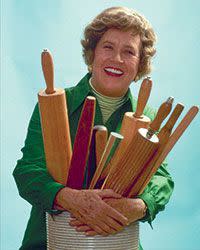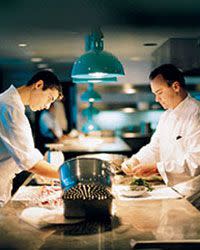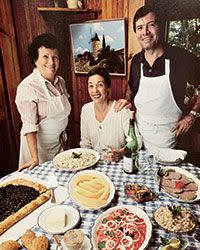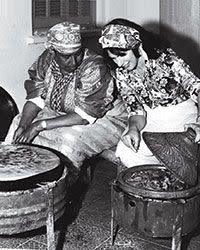F&W's 35th Anniversary: The Legends
- Oops!Something went wrong.Please try again later.
F&W is proud of the extraordinary, epoch-defining cooks who've contributed to our pages over the past 35 years. Here, our editors describe their encounters with greatness and share the lessons and recipes that have amazed them the most.

F&W’s Encounters with Famous Chefs

© Getty Images - Lee Lockwood
Julia Child
Contributor, 1989-2004
1996 Recipe: Hash Browns
1997 Recipe: Julia's Favorite Roast Chicken
In 1989, Julia Child became a contributor to F&W. I hadn't been on staff long, but I understood the considerable excitement this created. Julia was in her late seventies at that point, but one could argue she was only mid-career; she had published seven books and would go on to author or co-author 11 more. And so Julia became a member of the F&W family. She invited us into her Cambridge, Massachusetts, home for a Christmas feature in 1993. For a Valentine's Day column in 1998, she shared the illustrated cards she and her husband, Paul, would send to friends.
While people usually associate Julia with complex French dishes, many of her recipes for F&W, such as her roast chicken, weren't complicated at all. Julia always said that one can judge the quality of a cook by roast chicken, and that while it doesn't require years of training, it does entail "a greed for perfection". Her recipe for quiche Lorraine is also simple, extolling the "forbidden delights of eggs and butter and fat and calories." Julia warned against "fear of food," as she referred to it, insisting that some amount of fat was essential for good cooking, healthy brains and bodies and joyful eating.
Bottom line, Julia felt that we'd all be happier if we ate well, treasured our meals and cooked together. Countless times in the many years I worked with Julia, both before and after F&W, she'd turn to those of us around her in the kitchen and exclaim, "Isn't it so wonderful to cook with friends?" — Susy Davidson

Marcella Hazan
Contributor, 1978-2007
1997 Recipe: Marinated Poached Fresh Tuna with Caper + Anchovy Sauce
1997 Recipe: Fish in Crazy Water
1997 Recipe: Pasta with Abruzzi-Style Lamb Sauce
Marcella Hazan is an amazing home cook. This might sound like an overly simplistic description of the woman who introduced a generation of Americans to the Italian table more than 40 years ago with The Classic Italian Cookbook. But I know this because I've had the good fortune to work with Marcella a lot over the years. We've done stories together in Italy—at home with her husband, Victor, in Venice and in Venetian wine bars called bacari—and in the States, in New York City and on Long Island, New York, where they used to summer, as well as in Florida, where they live now. I've been lucky to spend time in the kitchen with Marcella and to eat at her table and I know that cooking at home every day, preparing lunch and dinner for herself and for Victor and their family and friends, is what makes her recipes so successful.
If you haven't read Amarcord, her memoir, here's the romantic backstory: In the mid-'50s, Marcella fell in love with Victor, a man who "could deal cheerily with most of life's ups and down but [never] with an indifferent meal." Victor was infatuated with food before that passion became a national sport, and it was Victor's appetite that first encouraged Marcella to cook. Together, at the table, they discovered that despite Marcella's inexperience in the kitchen, she had an innate and magical knack for cooking. And together, they have made her cooking their life's work: Every recipe, every cooking class, every book, has been a 50-50 Marcella and Victor collaboration.
Flavor has always come first for the Hazans. It's not that Marcella doesn't care about technique, she does, and she's quick to tell you why you should try pot-roasting meat in a tightly closed casserole on the stovetop or to explain the many merits of deep-frying just about anything. But taste trumps all. I remember trying to talk the Hazans out of many dishes that I knew would be a challenge to photograph —brown bean soups and pastas, and whole roasted veal shanks that resembled nuclear reac tor towers—but they always won. I often questioned the simplicity of a dish, but three of my favorite Marcella dishes—her legendary roast chicken with two lemons, the tomato sauce with butter, and grilled swordfish salmoriglio, with a sauce of olive oil, lemon and thyme — have fewer than five ingredients.
In revisiting Marcella's recipes for this story, I am reminded of the distinctive voice you'll find in all of her cookbooks, in both the headnotes and the recipes. It's the voice of Marcella and Victor's collaboration, erudite and elegant, often with a formality to it. I learned about their teamwork when we were shooting a story on Long Island in the '90s. I peeked into Marcella's neat ruled recipe notebooks, penned in longhand in perfect script, every word and every measurement in Italian. Every recipe of Marcella's has been interpreted for us by Victor, and they complement each other seamlessly.
The recipes here come from one of Victor's favorite books (and one of mine), the multi-award-winning Marcella Cucina, from 1997. In the endpapers, you too can peek into Marcella's notebook to find her original "manuscript," the hand-written recipes, in Italian, where the magic begins. — Tina Ujlaki

© Maura McEvoy
Jean-Georges Vongerichten
Contributor, 1990-present
2002 Recipe: Chinese Long Beans with Cracked Black Pepper
2007 Recipe: Spiced Chicken with Coconut-Caramel Sauce + Citrus Salad
2007 Recipe: Asian-Spiced Short Ribs
2011 Recipe: Roasted Brussels Sprouts with Toasted Pecans + Avocado
It isn't always easy getting Jean-Georges Vongerichten's attention. As his editor at F&W from 1997 to 2006, my job required pleading for time with him, focused as he was on running his empire of 30-plus restaurants in distant parts of the planet. Once I even volunteered to babysit his daughter in exchange for an interview.
Witnessing his culinary genius firsthand taught me a few things. I learned that, no matter how wildly different the cooking appears at each of his ventures, underlying it are a few essentials. They include an enduring love of Asian ingredients, prepared with classical technique. Lightness, which comes from vegetable juices, flavored oils, vinaigrettes and quick broths. ("I don't want the taste of boiled stock in a sauce," he once told me.) A contrast of textures and temperatures. ("If there's no contrast, we don't do it.") And a balance of heat, tang, vibrancy of fresh herbs and (optional) sweetness in every dish.
Ironically, after all those years of chasing Jean-Georges, these days I often bump into him when I stop for a ginger margarita at his Nougatine restaurant in Manhattan. I also feel like I'm hanging out with him when I make his recipes at home, where I've long since discovered that his simple dishes are as riveting as his intricate ones. — Jane Sigal
Video: Jean-Georges Vongerichten Cooking Demonstration

Jacques Pépin
Contributor, 1981-Present
1994 Recipe: Plum Galette
2007 Recipe: Beef Stew in Red Wine Sauce
2007 Recipe: Black Olive Tapenade with Figs + Mint
I think about Jacques Pépin every time I crack an egg (on the counter, not on the side of the bowl, to prevent bits of shell or bacteria from slipping in!). And all year long when I bake free-form tarts with his almost-instant, impossibly crisp, flaky and buttery dough that's as delicious as any puff pastry you'll ever try.
I came to Food & Wine almost straight from the classic French work-study (stagiaire) program at La Varenne in Paris. Jacques's books La Technique and La Methode were my bibles. I know I wasn't alone because I've spoken to many chefs who taught themselves to cook by working their way through those volumes. If only we had had the comprehensive technique video, which was released last year with the publication of his 20th cookbook, Essential Pépin. (You can see it at foodandwine.com/jacques-pepin-cooking-videos.)
By the time we started working together on the "Cooking with the Masters" column, Jacques had already published numerous books, his show on PBS was well under way and he had been named a dean of the French Culinary Institute in New York City. As Jacques's editor, my biggest challenge was choosing recipes from his infinite repertoire, but superstar that as he is (and has been for more than 35 years), getting in touch was as simple as picking up the phone and calling him at home. There was never a PR firm to go through, or a stable of handlers to bypass, just his amazing assistant — and my greatest ally — Norma Galehouse. Together they continue to juggle his book projects, TV tapings, and speaking and teaching engagements. (Jacques is also an adjunct professor at Boston University, where he launched the culinary certificate program with Julia Child in the late-'80s.)
When Jacques was teaching at FCI, we would sometimes meet for lunch (three courses with wine, always) at the school's restaurant, L'Ecole, to discuss future stories we might do together. I loved going back into the kitchens, where the students were making salad, and he would explain to them — and to me — the finer points of trimming a head of lettuce, or making a perfect vinaigrette (both critical skills, and neither one as simple to do perfectly as you might have thought). Another day, the lesson was on roast chicken, and as we walked past the ovens, Jacques pointed out which birds were done and which still needed more time—without ever opening an oven door. How did he know? He could tell exactly how far along the birds were just by listening to the sounds of the fat splattering in the roasting pans. He is the ultimate food whisperer.
We've traveled the world with Jacques in our pages, pursuing his many passions that always bring him back to the table, surrounded by family and close friends. We've featured dishes from his vast classic and regional French repertoire, recipes inspired by his travels and those that represent the best of fast, easy cooking. We've tagged along to ski in the winter and play boules in his backyard in the summer, to hunt for wild mushrooms in the damp woods of Connecticut in the spring and soak up the sun on the African plain, on a Mediterranean cruise or in Playa del Carmen, Mexico.
Jacques's family and friends always play a huge role every year at the Food & Wine Classic in Aspen, and I'm sure he'll have his daughter, Claudine, and his best friend, Jean-Claude Szurdak, in tow as sidekicks and foils. He'll have top chefs addressing him formally, as Chef, and attendees stopping him for his autograph. He will do a couple of great demos, looking straight out at the audience and explaining a point while perfectly mincing three large onions in half the time it would take me to peel one. I will be sitting in the front row, soaking it all in. — Tina Ujlaki

© Paula Wolfert
Paula Wolfert
Contributor, 1978-present
2001 Recipe: Slow-Cooked Duck with Green Olives + Herbes de Provence
2005 Recipe: Flaugnarde with Pears
2006 Recipe: Turkey Kibbe Kebabs with Two Sauces
Paula Wolfert has written for F&W since 1978. This might seem unusual, since she explores ancient ways of cooking with the same passion that F&W scouts new ones. But Paula is always making discoveries. In her articles, as in her nine seminal Mediterranean cookbooks, she explains obscure ingredients and complex techniques with enthusiasm and rigor — and minimal apology.
I edited Paula for four of her 35 years with F&W, and the experience made me a better, bolder cook. Her recipes challenged my assumptions. Take kebabs, which I once shrugged off as meat on a stick. She elevates them with deceptively complex seasonings and sauces. Or cake: Her recipe for pear cake, or flaugnarde, relies on ripe pear slices rather than sugar.
My relationship with Paula involved long phone conversations (sometimes half a day) and lots of emails (once she flooded my inbox with 20 revisions of a recipe that was delicious to begin with). But in 2008, I got to travel to Marrakech with her — a dream. As she quizzed a sausage vendor about his grilling technique, I worried he'd get annoyed. But like the rest of us, he warmed immediately to this exuberant woman with her insatiable curiosity about food. — Emily Kaiser Thelin
For more Food & Wine news, make sure to sign up for our newsletter!
Read the original article on Food & Wine.
